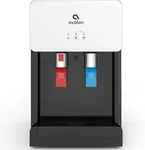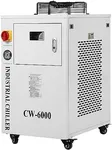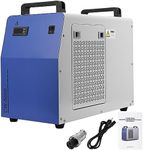Buying Guide for the Best Hot And Cold Water Dispensers
Choosing the right hot and cold water dispenser can significantly enhance your convenience and hydration habits. These appliances are designed to provide you with instant access to hot and cold water, making them ideal for both home and office use. When selecting a water dispenser, it's important to consider several key specifications to ensure you get the best fit for your needs. Understanding these specifications will help you make an informed decision and choose a dispenser that meets your requirements effectively.Water Temperature RangeThe water temperature range indicates how hot or cold the water can get. This is important because it determines the versatility of the dispenser. For hot water, look for a dispenser that can reach temperatures around 185-200°F, which is ideal for making tea, coffee, or instant soups. For cold water, a range of 40-50°F is typically refreshing. If you need very hot water for cooking or very cold water for a hot climate, choose a dispenser with a wider temperature range.
CapacityCapacity refers to the amount of water the dispenser can hold and dispense at a time. This is crucial for ensuring that the dispenser meets your daily water consumption needs. Smaller units may hold around 2-3 gallons, suitable for personal or small family use. Larger units can hold 5 gallons or more, ideal for offices or larger households. Consider your daily water usage and choose a capacity that ensures you won't need to refill the dispenser too frequently.
Filtration SystemA filtration system in a water dispenser ensures that the water you drink is clean and free from contaminants. This is important for health and taste. Some dispensers come with built-in filters that remove impurities, while others may require you to use pre-filtered water. If you are concerned about water quality, look for a dispenser with a multi-stage filtration system that can remove chlorine, lead, and other harmful substances. Choose a filtration system based on the quality of your tap water and your health priorities.
Energy EfficiencyEnergy efficiency indicates how much power the dispenser uses to heat and cool water. This is important for reducing your electricity bills and environmental impact. Look for dispensers with an Energy Star rating or those that have energy-saving modes. These models are designed to use less power while still providing hot and cold water efficiently. If you are conscious about energy consumption, choose a model that balances performance with energy efficiency.
Design and SizeThe design and size of the water dispenser affect where you can place it and how it fits into your space. This is important for ensuring that the dispenser is convenient to use and complements your decor. Compact models are great for small kitchens or offices, while larger, freestanding units are better for spacious areas. Consider the available space in your home or office and choose a design that fits well without being obtrusive.
Ease of UseEase of use refers to how simple it is to operate and maintain the dispenser. This is important for ensuring that everyone can use it without difficulty. Look for features like easy-to-use buttons, clear indicators for hot and cold water, and simple maintenance requirements. If you have children or elderly users, consider a dispenser with safety features like child locks on the hot water tap. Choose a model that offers convenience and safety for all users.
Noise LevelNoise level indicates how much sound the dispenser makes while operating. This is important for maintaining a quiet environment, especially in offices or homes where noise can be disruptive. Some dispensers operate very quietly, while others may produce noticeable noise when heating or cooling water. If you prefer a quieter appliance, look for models that are specifically designed to minimize noise. Consider where you will place the dispenser and choose one that won't disturb your peace.




















